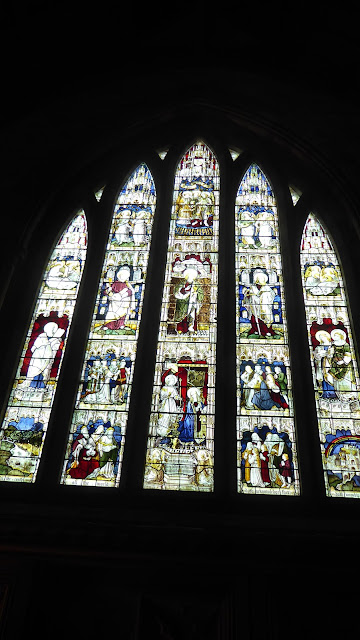Yesterday was a welcome day out - having been tied to the locale for the last fortnight as the car is off the road, and my friend P gave me a lift to and from town so I didn't have to walk. The trip had been organized by a lady in our town History group, and we were to visit 3 churches, have lunch at the Elan Valley visitor's centre, and come home via Cors-y-Llyn bog.
This is the Church of St John Divine, at Cwmbach, between Builth and Newbridge-on-Wye. It has been closed for the past five years because of problems with the bells and the back chimney, which rendered it dangerous. Keith and I stopped to check this one out a couple of years ago, but it was shut then. The bells(which came from Switzerland, as did the original ones) have now been replaced. 
It was sponsored by a local philanthropist, Miss Clara Thomas of Llywn Madoc, Breconshire and nearby Pencarrig. Our host told us that the church was built in memory of Miss Thomas's mother (also named Clara) who died in 1877, and it apparently cost £12,000 to build in 1887, and has definite Italianate influence, because Miss Thomas had visited Italy many times. Apparently the small carved heads inside and out of the church showed this Italian influence, as did the use of Italian marble inside. The company of J B Fowler of Brecon undertook the construction and the stained glass was by Burlison and Grylls.
The beautiful outer wrought iron door was donated by a friend, and I loved these strapwork hinges on the wooden door.
Sorry this isn't very legible, but says that the iron gates were wrought in Italy.
Stained glass windows in the porch. Stained glass by Burlison and Grylls. There was a similar window opposite.
Beautifully inlaid with squares of Italian marble, this font gives a design nod to Norman times, with the multiple legs. I don't think I've ever seen one with inlays like this.
This is the huge and detailed glass of the West window.
A memorial window on the North wall of the church.
Above and below, the altar and the absolutely lovely carved marble rerados and the gold and lilies Alleluja plaque, made - as you will recognize from recent posts of mine - as a mosaic.
These stained glass memorial windows had a much bolder design style and were added later. The bottom one is 1905.
Our host also told us that the benefactress would spend the winter in one house (Pencarrig) and then transport all the livestock and necessities (including her grand piano on a gambo - a sort of cart) across the rough lanes to her other property, Llywn Madoc, over the Breconshire border, for the summer. If you do a search on these properties you will find photos of how they look now. Lovely houses.
Then it was onto the next church, Disserth, which Keith and I had first visited when we moved here.
Billy Blue Eyes - the church has now been opened for services again, but you would probably have to turn up on the day when it was holding the service to see inside.













isn't it lovely that you have someone who cares enough to offer you a helping hand/lift? So pleased you were able to join the outing.
ReplyDeleteI have a couple of good friends I can call on to give me a lift etc, and the farmers up the hill very helpful too.
DeleteThe door with the unusual flowered strap hinges is so beautiful.
ReplyDeleteThe Arts & Crafts/Art Nouveau influence.
DeleteI have never seen a hinge hanging down from the top of the door. Most interesting! That is an amazing church. All of it! Thanks for the pictures.
ReplyDeleteWell, the actual swinging hinge still on the long side of the door, so this is just embellishment.
ReplyDeleteI did get a message from Judith to say she had been there and told me how wonderful it was inside. I must try and get along there
ReplyDelete